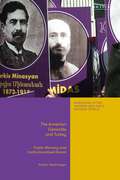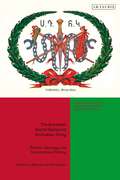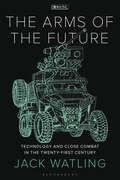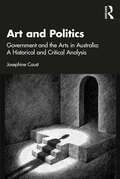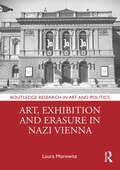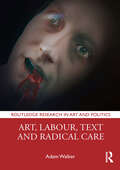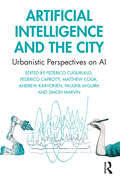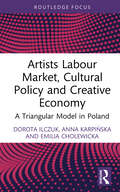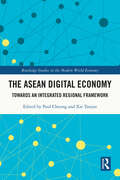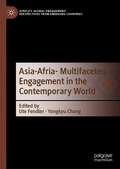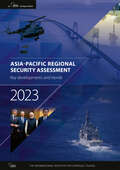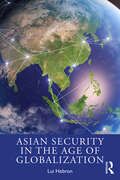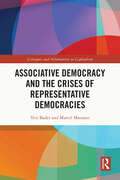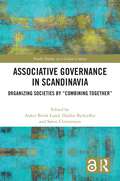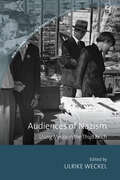- Table View
- List View
The Armenian Genocide and Turkey: Public Memory and Institutionalized Denial (Armenians in the Modern and Early Modern World)
by Hakan SeckinelginHow is official denial of the Armenian genocide maintained in Turkey? In this book, Hakan Seckinelgin investigates the mechanisms by which denial of the events of 1915 are reproduced in official discourse, and the effect this has on Turkish citizens. Examining state education, media discourse, academic publications, as well as public events debating the Armenian genocide, the book argues that, at the public level, there exists a 'grammar' or 'repertoire' of denial in Turkey which regulates how the issue can be publicly conceptualised and understood. The book's careful analysis examines the way that knowledge about the genocide is censored in Turkey, from the language that must be used to publicly discuss it, to the complex way in which selective knowledge and erased history is reproduced, from 1915 and subsequent generations until today. It argues that denialism has become important to a certain kind Turkish national identity and belonging – and suggests ways in which this relationship can be unpicked in future.
The Armenian Social Democrat Hnchakian Party: Politics, Ideology and Transnational History (Armenians in the Modern and Early Modern World)
by Bedross Der MatossianThis book, based on new research, sheds light on the history of the Social Democrat Hnchakian Party, a major Armenian revolutionary party that operated in the Ottoman Empire, Russia, Persia and throughout the global Armenian diaspora. Divided into sections which cover the origins, ideology, and regional history of the SDHP, the book situates the history of the Hnchaks within debates around socialism, populism, and nationalism in the 19th and 20th centuries. The SDHP was not only an Armenian party but had a global Marxist outlook, and scholars in this volume bring to bear expertise in a wide range of histories and languages including Russian, Turkish, Persian and Latin American to trace the emergence and role this influential party played from their split with the Armenian Revolutionary Federation and the events of the Armenian genocide to the formation of the first Armenian Republic and then Soviet Armenia. Putting the Hnchaks in context as one of many nationalist radical groups to emerge in Eurasia in the late 19th century, the book is an important contribution to Armenian historiography as well as that of transnational revolutionary movements in general.
The Arms of the Future: Technology and Close Combat in the Twenty-First Century (New Perspectives on Defence and Security)
by Jack WatlingFrom sensor-fuzed munitions and autonomous weapons, to ground moving target indication radar, laser vibrometers and artificial intelligence, the weapons of warfare are undergoing a rapid transformation, with modern technologies reshaping how armies intend to fight in the twenty-first century. The Arms of the Future analyses how the emergence of novel weapons systems is shaping the risks and opportunities on the battlefield. Drawing on extensive practical observation and experimentation, the book unpacks the operational challenges new weapons pose on the battlefield and how armies might be structured to overcome them. At a time when defence spending across NATO is on the rise, and conflict with Russia raises new questions of what it means to fight a truly 'modern' war, Watling examines not just the arms to be employed but how they can be fielded and wielded to survive and prevail in future wars.
Art and Politics: Government and the Arts in Australia: A Historical and Critical Analysis
by Josephine CaustAustralian governments at all levels have been engaged with arts and culture in many different forms since the beginning of European settlement. The way this has occurred is documented and analysed here, both from an historical and critical perspective. Changing understandings of culture and the significance of Indigenous Culture to Australia receive special attention. While the focus is primarily directed to Federal Government engagement, there is also consideration paid to both state and local government involvement. There is attention paid to the censorship of arts practice by governments as well as the direct interventions by politicians in arts practice. Different approaches to the arts by governments are also considered, as well as attempts to develop a national cultural policy. The impact of the recent pandemic is addressed and various research reports about the arts sector and its relationship with government are also noted. There is then a final discussion about some issues that governments could address in the future, that might ensure a more sustainable Australian arts sector. This book will be of particular interest to scholars of contemporary arts, arts management, cultural history, public policy and cultural policy. It may also interest bureaucrats and politicians.
Art and Politics: Government and the Arts in Australia: A Historical and Critical Analysis
by Josephine CaustAustralian governments at all levels have been engaged with arts and culture in many different forms since the beginning of European settlement. The way this has occurred is documented and analysed here, both from an historical and critical perspective. Changing understandings of culture and the significance of Indigenous Culture to Australia receive special attention. While the focus is primarily directed to Federal Government engagement, there is also consideration paid to both state and local government involvement. There is attention paid to the censorship of arts practice by governments as well as the direct interventions by politicians in arts practice. Different approaches to the arts by governments are also considered, as well as attempts to develop a national cultural policy. The impact of the recent pandemic is addressed and various research reports about the arts sector and its relationship with government are also noted. There is then a final discussion about some issues that governments could address in the future, that might ensure a more sustainable Australian arts sector. This book will be of particular interest to scholars of contemporary arts, arts management, cultural history, public policy and cultural policy. It may also interest bureaucrats and politicians.
Art, Exhibition and Erasure in Nazi Vienna (Routledge Research in Art and Politics)
by Laura MorowitzThis book examines three exhibitions of contemporary art held at the Vienna Künstlerhaus during the period of National Socialist rule and shows how each attempted to culturally erase elements anathema to Nazi ideology: the City, the Jewess and fin-de-siècle Vienna. Each of the exhibits was large scale and ambitious, part of a broader attempt to situate Vienna as the cultural capital of the Reich, and each aimed to reshape cultural memory and rewrite history. Applying illuminating theories on memory studies, collective and public memory, and notions of "memoricide," this is the first book in English to focus on visual culture in the period when Austria was erased as a nation and incorporated into the Third Reich as "Ostmark." The organization, content and publications surrounding these three exhibits are explored in depth and set against the larger political changes and dangerous ideologies they reflect. The book will be of interest to scholars working in art history, museum studies, cultural history, memory studies, art and politics and Holocaust studies.
Art, Exhibition and Erasure in Nazi Vienna (Routledge Research in Art and Politics)
by Laura MorowitzThis book examines three exhibitions of contemporary art held at the Vienna Künstlerhaus during the period of National Socialist rule and shows how each attempted to culturally erase elements anathema to Nazi ideology: the City, the Jewess and fin-de-siècle Vienna. Each of the exhibits was large scale and ambitious, part of a broader attempt to situate Vienna as the cultural capital of the Reich, and each aimed to reshape cultural memory and rewrite history. Applying illuminating theories on memory studies, collective and public memory, and notions of "memoricide," this is the first book in English to focus on visual culture in the period when Austria was erased as a nation and incorporated into the Third Reich as "Ostmark." The organization, content and publications surrounding these three exhibits are explored in depth and set against the larger political changes and dangerous ideologies they reflect. The book will be of interest to scholars working in art history, museum studies, cultural history, memory studies, art and politics and Holocaust studies.
Art, Labour, Text and Radical Care (Routledge Research in Art and Politics)
by Adam WalkerThrough developing an ethical-methodological approach of ‘radical care', this book explores how critical artistic practice might contribute to the materialisation of more equal, more collectively fulfilling, possibilities of being. The chapters trace a set of interweaving lineages perpetuating inequalities: through labour, the body, and onto-epistemology. Art’s all too frequent a-criticality, cooption, or even complicity amidst these lineages is observed, and radical care and the disruptive arttext are developed as twin aspects of an alternative, resistant framework. The book contributes to the critical understanding of inequitable, abstracting processes’ growing determination of increasing parts of our world, and foregrounds art’s position amidst these. It also functions as an interface, both extending the fertile current discourse around care to a contemporary art focus, and at the same time exploring how radical art practices might contribute to a politics rooted in an ethics of care. The book will be of interest to scholars working in art history, studio art, philosophy and politics.
Art, Labour, Text and Radical Care (Routledge Research in Art and Politics)
by Adam WalkerThrough developing an ethical-methodological approach of ‘radical care', this book explores how critical artistic practice might contribute to the materialisation of more equal, more collectively fulfilling, possibilities of being. The chapters trace a set of interweaving lineages perpetuating inequalities: through labour, the body, and onto-epistemology. Art’s all too frequent a-criticality, cooption, or even complicity amidst these lineages is observed, and radical care and the disruptive arttext are developed as twin aspects of an alternative, resistant framework. The book contributes to the critical understanding of inequitable, abstracting processes’ growing determination of increasing parts of our world, and foregrounds art’s position amidst these. It also functions as an interface, both extending the fertile current discourse around care to a contemporary art focus, and at the same time exploring how radical art practices might contribute to a politics rooted in an ethics of care. The book will be of interest to scholars working in art history, studio art, philosophy and politics.
Artificial Intelligence and the City: Urbanistic Perspectives on AI
This book explores in theory and practice how artificial intelligence (AI) intersects with and alters the city. Drawing upon a range of urban disciplines and case studies, the chapters reveal the multitude of repercussions that AI is having on urban society, urban infrastructure, urban governance, urban planning and urban sustainability. Contributors also examine how the city, far from being a passive recipient of new technologies, is influencing and reframing AI through subtle processes of co-constitution. The book advances three main contributions and arguments: First, it provides empirical evidence of the emergence of a post-smart trajectory for cities in which new material and decision-making capabilities are being assembled through multiple AIs. Second, it stresses the importance of understanding the mutually constitutive relations between the new experiences enabled by AI technology and the urban context. Third, it engages with the concepts required to clarify the opaque relations that exist between AI and the city, as well as how to make sense of these relations from a theoretical perspective. Artificial Intelligence and the City offers a state-of-the-art analysis and review of AI urbanism, from its roots to its global emergence. It cuts across several disciplines and will be a useful resource for undergraduates and postgraduates in the fields of urban studies, urban planning, geography, architecture, urban design, science and technology studies, sociology and politics.
Artificial Intelligence and the City: Urbanistic Perspectives on AI
by Federico Cugurullo Federico Caprotti Matthew Cook Andrew Karvonen Pauline McGuirk Simon MarvinThis book explores in theory and practice how artificial intelligence (AI) intersects with and alters the city. Drawing upon a range of urban disciplines and case studies, the chapters reveal the multitude of repercussions that AI is having on urban society, urban infrastructure, urban governance, urban planning and urban sustainability. Contributors also examine how the city, far from being a passive recipient of new technologies, is influencing and reframing AI through subtle processes of co-constitution. The book advances three main contributions and arguments: First, it provides empirical evidence of the emergence of a post-smart trajectory for cities in which new material and decision-making capabilities are being assembled through multiple AIs. Second, it stresses the importance of understanding the mutually constitutive relations between the new experiences enabled by AI technology and the urban context. Third, it engages with the concepts required to clarify the opaque relations that exist between AI and the city, as well as how to make sense of these relations from a theoretical perspective. Artificial Intelligence and the City offers a state-of-the-art analysis and review of AI urbanism, from its roots to its global emergence. It cuts across several disciplines and will be a useful resource for undergraduates and postgraduates in the fields of urban studies, urban planning, geography, architecture, urban design, science and technology studies, sociology and politics.
Artists Labour Market, Cultural Policy and Creative Economy: A Triangular Model in Poland (Routledge Focus on Economics and Finance)
by Dorota Ilczuk Anna Karpińska Emilia CholewickaFocusing on artists and creators, this shortform book analyses the labour market in the creative economy in the context of cultural policies.Based on a series of studies involving Polish artists spanning 10 years, the book identifies the key factors needed to understand contemporary labour markets in the creative and cultural sectors worldwide. The authors integrate artists’ perspectives to present truly rounded evidence, shedding light on the applicational perspective of the research findings.Illuminating the socioeconomic status of artists in Poland, this book is essential reading for researchers interested in cultural policy and the creative economy, as well as work and labour studies more broadly. It will also be of interest to practitioners in the creative and cultural industries.
Artists Labour Market, Cultural Policy and Creative Economy: A Triangular Model in Poland (Routledge Focus on Economics and Finance)
by Dorota Ilczuk Anna Karpińska Emilia CholewickaFocusing on artists and creators, this shortform book analyses the labour market in the creative economy in the context of cultural policies.Based on a series of studies involving Polish artists spanning 10 years, the book identifies the key factors needed to understand contemporary labour markets in the creative and cultural sectors worldwide. The authors integrate artists’ perspectives to present truly rounded evidence, shedding light on the applicational perspective of the research findings.Illuminating the socioeconomic status of artists in Poland, this book is essential reading for researchers interested in cultural policy and the creative economy, as well as work and labour studies more broadly. It will also be of interest to practitioners in the creative and cultural industries.
The ASEAN Digital Economy: Towards an Integrated Regional Framework (Routledge Studies in the Modern World Economy)
Boasting the fastest growing Internet market in the world, Association of Southeast Asian Nations (ASEAN) is accelerating into the digital economy. This book assesses the potential economic impact of digital economy agreements (DEAs) and the readiness of some ASEAN member states to grow the digital economy in collaboration. The book presents a novel framework to assess countries’ readiness to enter digital economy collaborations, following the architecture of Singapore’s DEAs with its trading partners. It takes a bird’s-eye view of the digital economy in ASEAN and reviews the current state of digital infrastructure and regulations. The book also includes simulation exercises to project economic outcomes delivered by regional collaborations. It also elaborates on the specific strengths and weaknesses of five ASEAN member states. These ASEAN member states include Indonesia, Malaysia, the Philippines, Vietnam, and Cambodia. The book concludes by revisiting the ASEAN economy as a whole. It points out key issues country leaders need to work on as they proceed with digital economy collaborations. This book is written for scholars, policymakers, and industrial practitioners who wish to learn the latest developments in the ASEAN digital economy.
The ASEAN Digital Economy: Towards an Integrated Regional Framework (Routledge Studies in the Modern World Economy)
by Paul Cheung Xie TaojunBoasting the fastest growing Internet market in the world, Association of Southeast Asian Nations (ASEAN) is accelerating into the digital economy. This book assesses the potential economic impact of digital economy agreements (DEAs) and the readiness of some ASEAN member states to grow the digital economy in collaboration. The book presents a novel framework to assess countries’ readiness to enter digital economy collaborations, following the architecture of Singapore’s DEAs with its trading partners. It takes a bird’s-eye view of the digital economy in ASEAN and reviews the current state of digital infrastructure and regulations. The book also includes simulation exercises to project economic outcomes delivered by regional collaborations. It also elaborates on the specific strengths and weaknesses of five ASEAN member states. These ASEAN member states include Indonesia, Malaysia, the Philippines, Vietnam, and Cambodia. The book concludes by revisiting the ASEAN economy as a whole. It points out key issues country leaders need to work on as they proceed with digital economy collaborations. This book is written for scholars, policymakers, and industrial practitioners who wish to learn the latest developments in the ASEAN digital economy.
Asia-Afria- Multifaceted Engagement in the Contemporary World (Africa's Global Engagement: Perspectives from Emerging Countries)
by Ute Fendler Yongkyu ChangThis book provides an insight into the complex entanglements between African countries and India, China, and South Korea from multidisciplinary perspectives connecting approaches from cultural, anthropological, literary, and music studies and art history. The three parts present a regional focus, namely Africa-India, Africa-South Korea, and Africa-China while the single contributions speak to each other and offer complementary insights. At the same time, the chapters also link across the regional realms as they deal with similar topics, such as travelling music genres. In part I, for Pombo material culture is the starting point to investigate the connections between the islands of the Indian Ocean and India by questioning the construction of memory. It highlights various aspects of the multilayered history of connections between Africa, the islands, and India. Part II gathers contributions that are complimentary to each other and therefore contribute to the understanding of the complex entanglements in area studies. Part III (Africa-South Korea) explores the impact of African-American arts and artists on South Korea's popular culture as well as the changing perception of artists of African descent in visual popular culture. It shows the impact of Korean content in South Africa.
Asia-Pacific Regional Security Assessment 2023: Key developments and trends
by The International Institute for Strategic StudiesThe Asia-Pacific Regional Security Assessment examines key regional security issues relevant to the policy-focused discussions of the IISS Shangri-La Dialogue, Asia’s premier defence summit convened by the International Institute for Strategic Studies. It is published and launched at the Dialogue and the issues analysed within its covers are central to discussions at the event. Since February 2022, the war in Ukraine has provided a bleak backdrop for discussions about international security. While the war has affected many aspects of security and defence in the Asia-Pacific, the region also has its own dynamics, and important security-related developments have occurred there since the invasion. Among these, China’s ever-growing power and increasingly assertive posture remain the leading long-term challenges for the region. This tenth edition of the Asia-Pacific Regional Security Assessment contains an introduction and six chapters, authored by IISS experts, which investigate important dimensions of the regional security environment, supported by maps, graphs, charts and tables. Topics include: the war in Ukraine and the Asia-Pacific balance of power; strained US- China relations and the growing threat to Taiwan; Asia-Pacific naval and maritime capabilities; China’s Belt and Road Initiative; Japanese security and defence policy; and the conflict in Myanmar and the international response. Authors include leading regional analysts and academics at the forefront of research and analysis: James Crabtree, Euan Graham, Nigel Inkster, Nick Childs, Meia Nouwens, Robert Ward, Yuka Koshino, Aaron Connelly and Shona Loong
Asia-Pacific Regional Security Assessment 2023: Key developments and trends
The Asia-Pacific Regional Security Assessment examines key regional security issues relevant to the policy-focused discussions of the IISS Shangri-La Dialogue, Asia’s premier defence summit convened by the International Institute for Strategic Studies. It is published and launched at the Dialogue and the issues analysed within its covers are central to discussions at the event. Since February 2022, the war in Ukraine has provided a bleak backdrop for discussions about international security. While the war has affected many aspects of security and defence in the Asia-Pacific, the region also has its own dynamics, and important security-related developments have occurred there since the invasion. Among these, China’s ever-growing power and increasingly assertive posture remain the leading long-term challenges for the region. This tenth edition of the Asia-Pacific Regional Security Assessment contains an introduction and six chapters, authored by IISS experts, which investigate important dimensions of the regional security environment, supported by maps, graphs, charts and tables. Topics include: the war in Ukraine and the Asia-Pacific balance of power; strained US- China relations and the growing threat to Taiwan; Asia-Pacific naval and maritime capabilities; China’s Belt and Road Initiative; Japanese security and defence policy; and the conflict in Myanmar and the international response. Authors include leading regional analysts and academics at the forefront of research and analysis: James Crabtree, Euan Graham, Nigel Inkster, Nick Childs, Meia Nouwens, Robert Ward, Yuka Koshino, Aaron Connelly and Shona Loong
Asian Security in the Age of Globalization
by Lui HebronThis book examines the security challenges and opportunities that the nation-states of Asia confront in an era of globalization. With consideration of the increasingly border-less nature of international relations via the integrative process of globalization, this book explores the emerging threats to regional and national security in Asia. It looks beyond traditional military threats, analysing non-traditional aspects of security including economic, social, environmental, transnational, energy, health concerns and threats posed by organized-crime groups. Its approach is organized both theoretically and, in a country-specific, case study form which provides contemporary examples of the threats faced in the region. By acknowledging that contemporary Asian security has become much more complex and complicated, it highlights the uncertainty and instability that the nation-states of the Indo-Pacific region confront. Presenting both a globally oriented and expanded vision of Asian security, this book is an excellent resource for scholars and students of Asian Studies, International Relations and Global Studies.
Asian Security in the Age of Globalization
This book examines the security challenges and opportunities that the nation-states of Asia confront in an era of globalization. With consideration of the increasingly border-less nature of international relations via the integrative process of globalization, this book explores the emerging threats to regional and national security in Asia. It looks beyond traditional military threats, analysing non-traditional aspects of security including economic, social, environmental, transnational, energy, health concerns and threats posed by organized-crime groups. Its approach is organized both theoretically and, in a country-specific, case study form which provides contemporary examples of the threats faced in the region. By acknowledging that contemporary Asian security has become much more complex and complicated, it highlights the uncertainty and instability that the nation-states of the Indo-Pacific region confront. Presenting both a globally oriented and expanded vision of Asian security, this book is an excellent resource for scholars and students of Asian Studies, International Relations and Global Studies.
Associative Democracy and the Crises of Representative Democracies (Critiques and Alternatives to Capitalism)
by Veit Bader Marcel MaussenThe familiar problems of democratic capitalism have given way to a deep crisis challenging the basic forms of governance introduced around the late 18th century and then gradually expanded and developed until the late 20th century. Associative Democracy and the Crises of Representative Democracies argues that we are in urgent need of normative guidelines and a strong understanding of a broad range of institutional options and innovative experiments in associative democracy in order to address the structural problems that existing institutional arrangements are confronted with whilst maintaining and strengthening democratic forms of government and governance. The argument is developed against the background of a thorough survey of empirical social scientific studies on the crises of capitalisms and representative democracies. This book focuses primarily on democratic alternatives, though it also works out principles and institutions of democratic socialism as alternatives to capitalism. After introducing the theoretical approach, the book illustrates the ways this framework of analysis can be of use, with particular focus on three issues that are highly topical when it comes to the challenges our institutions are confronted with: democratic governance in relation to ecological crises and uncertainty; the threats to democracy raised by the crisis of political parties and representative party-democracy, and the challenges related to privatization and marketization of public services, particularly in healthcare. The book concludes by exploring opportunities to democratize the economy, locating viable alternatives to capitalism in the tradition of democratic socialism. This urgent and thought-provoking book will be of great interest to academics and students in various disciplines in the humanities and social sciences, including political science, sociology, and economics.
Associative Democracy and the Crises of Representative Democracies (Critiques and Alternatives to Capitalism)
by Veit Bader Marcel MaussenThe familiar problems of democratic capitalism have given way to a deep crisis challenging the basic forms of governance introduced around the late 18th century and then gradually expanded and developed until the late 20th century. Associative Democracy and the Crises of Representative Democracies argues that we are in urgent need of normative guidelines and a strong understanding of a broad range of institutional options and innovative experiments in associative democracy in order to address the structural problems that existing institutional arrangements are confronted with whilst maintaining and strengthening democratic forms of government and governance. The argument is developed against the background of a thorough survey of empirical social scientific studies on the crises of capitalisms and representative democracies. This book focuses primarily on democratic alternatives, though it also works out principles and institutions of democratic socialism as alternatives to capitalism. After introducing the theoretical approach, the book illustrates the ways this framework of analysis can be of use, with particular focus on three issues that are highly topical when it comes to the challenges our institutions are confronted with: democratic governance in relation to ecological crises and uncertainty; the threats to democracy raised by the crisis of political parties and representative party-democracy, and the challenges related to privatization and marketization of public services, particularly in healthcare. The book concludes by exploring opportunities to democratize the economy, locating viable alternatives to capitalism in the tradition of democratic socialism. This urgent and thought-provoking book will be of great interest to academics and students in various disciplines in the humanities and social sciences, including political science, sociology, and economics.
Associative Governance in Scandinavia: Organizing Societies by “Combining Together” (Nordic Studies in a Global Context)
This edited volume explores a variety of aspects of associative governance, providing detailed case studies of associations and associational governance in Scandinavia. Theoretically developing a concept and approach of associative governance, the book sheds light on a dynamic way of perceiving associative aspects of community and commercial life that has been hitherto underexplored and undertheorized. It shows how governance by associations may be conducted not only bottom‑up by self‑organized and voluntary participation, but also top‑down by authoritative incorporation through government, and – not least – in multifarious interstices in between.By exploring a vibrant panoply of dimensions of associative governance, empirically grounded in historical analyses of a wide range of organizational repertoires, the book may provide novel insights into the significant role of associative governance in Scandinavia over the past two centuries. Finally, it provides research‑based knowledge about how to maintain “good political and economic institutions” in the future and a more holistic and dynamic approach to the literature on The Nordic model.The book will be of key interest to scholars and students of Nordic and Scandinavian studies, history, sociology, political science, marketing, social policy, organization theory, and public management.The Open Access version of this book, available at www.taylorfrancis.com, has been made available under a Creative Commons Attribution‑Non Commercial‑No Derivatives (CC‑BY‑NC‑ND) 4.0 license.
Associative Governance in Scandinavia: Organizing Societies by “Combining Together” (Nordic Studies in a Global Context)
by Anker Brink Lund Haldor Byrkjeflot Søren ChristensenThis edited volume explores a variety of aspects of associative governance, providing detailed case studies of associations and associational governance in Scandinavia. Theoretically developing a concept and approach of associative governance, the book sheds light on a dynamic way of perceiving associative aspects of community and commercial life that has been hitherto underexplored and undertheorized. It shows how governance by associations may be conducted not only bottom‑up by self‑organized and voluntary participation, but also top‑down by authoritative incorporation through government, and – not least – in multifarious interstices in between.By exploring a vibrant panoply of dimensions of associative governance, empirically grounded in historical analyses of a wide range of organizational repertoires, the book may provide novel insights into the significant role of associative governance in Scandinavia over the past two centuries. Finally, it provides research‑based knowledge about how to maintain “good political and economic institutions” in the future and a more holistic and dynamic approach to the literature on The Nordic model.The book will be of key interest to scholars and students of Nordic and Scandinavian studies, history, sociology, political science, marketing, social policy, organization theory, and public management.The Open Access version of this book, available at www.taylorfrancis.com, has been made available under a Creative Commons Attribution‑Non Commercial‑No Derivatives (CC‑BY‑NC‑ND) 4.0 license.
Audiences of Nazism: Using Media in the Third Reich (New German Historical Perspectives #13)
by Ulrike WeckelThrough its focus on audiences and their reception of media in Nazi Germany, Audiences of Nazism inverts the typical top-down perspective employed in studies that concentrate on the regime’s regulation of media and propaganda. It thereby sheds new light on the complex character of the period’s media, their uses, and the scope for audience interpretation. Contributors investigate how consumers either appropriated or ignored certain messages of Nazi propaganda, and how some even participated in its production. The authors ground their studies on novel historical sources, including private diaries and letters, photographs and films, and concert programs, which demonstrate, amongst other things, how audiences interpreted and responded to regulated news, Nazi Party rallies, and the regime’s denunciation of modern works of art as ‘degenerate.’
